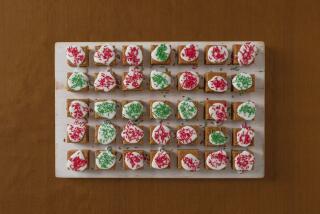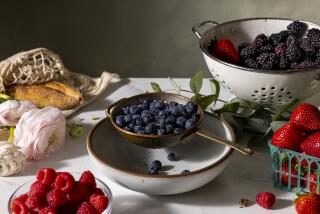The Time of Food : A World of Berries
- Share via
The Indians of North America were very knowledgeable about raspberries and blackberries. They cherished the sweet fruits fresh; they also dried them and added them to cooked preparations. They used the leaves for tea, the bark and root of the plant for medicinal purposes and the berries themselves as dyes. They passed along their knowledge to the first settlers, who in turn introduced the European berry varieties to the New World.
The American woods and prairies were a natural environment for berries and for a long time there was no need to cultivate them. But as small towns grew into big cities, it became more difficult for city-dwellers to “go berrying.” By the mid-1800s, commercial production was established, with seasonal shipping on the first railroads to major metropolitan areas.
The early 1800s had already brought hybridization of the native and European berry varieties, improving yield, size and quality. America became a world leader in hybridization and cultivation, but as the yields increased, the flavor diminished, especially when compared to the smaller wild berries.
Botanically speaking, a true berry is a fleshy fruit that develops from a single ovary but has several seeds. Fruits of the Rubus family, such as raspberries and blackberries, don’t exactly fit that description but are considered berries anyway. A Rubus family “berry” is actually an aggregate of many tiny fruits with each rounded fruit section enclosing a single seed.
The Rubus family includes more than 2,000 naturally occurring and hybrid varieties. Although the variations are often minute, the following varieties represent the most common species.
* Red raspberries are the most popular of the family. Most species under cultivation in America are hybrids of the native American and European strains. The color and flavor vary depending on the variety, soil composition and climate.
* Blackcap or black raspberries are also called thimbleberries because of their rounded shape and small size. They are deep-crimson to black in color. Black raspberries are higher in acid and considered the best for cooking. There is a cross between the red and black raspberries that produces a purple raspberry of some note.
* Golden raspberries are a cross between the red raspberry and the Asian yellow raspberry. The flavor is sweeter and a little less intense than the red raspberry. The golden color is captivating. They look very similar to the Scandinavian cloudberry, a distant cousin whose flavor is nowhere near as good.
* The blackberry family is well known in Europe--the prickly shrubs are called bramble in England and Scotland. Blackberries have a high acid content and intense flavor, but their seeds are quite large and should be strained and removed when they are cooked.
There are two principal varieties in America--the Evergreen and the Highbush blackberries, both found under cultivation and in the wild. The Evergreen blackberry is identifiable by its deep-green leaves and large berry clusters. The Highbush blackberry produces long canes or stems to heights of six feet, if trained, and has a larger berry size. The dewberry is the Southern or warm-weather cousin of the blackberry.
* Loganberries are a red brambleberry or blackberry. They were named for Judge Logan of California in 1881. The flavor reflects its heritage, and they may be eaten from the plant or in cooked preparations.
Whatever the variety, select berries that have deep color and a dry surface. They should be ripe and supple but never soft and mushy. The fragrance of ripe berries at room or market temperature should be pronounced. Taste the berries to identify their sweetness and flavor. They may look great but taste is the best part. Refrigerate with ventilation until ready to serve.
Wash the berries under trickling cold water only moments before serving and allow to drain well in a colander. Carefully place the berries onto a baking sheet or shallow dish to sort out the imperfect berries.
Tart berries or underripe ones may be sweetened with sugar, although I prefer using maple sugar or light syrup. If the flavor is still lacking, add a touch of balsamic vinegar along with the maple sweetener to balance the flavor. Berries are best when cooked quickly over gentle heat. The fruit is quite delicate even when underripe and will quickly turn to mush. Add half of the berries into the preparation and cook until the background flavor has been developed, then combine the remaining berries, cooking for just a few seconds to preserve the shape and fresh flavor.
BERRIES WITH WHITE CHOCOLATE ICE CREAM AND SHORTCAKE
3 pints fresh raspberries
1/4 cup maple sugar or syrup
1/4 cup Cognac
4 Shortcakes
4 scoops White Chocolate Ice Cream
Powdered sugar, optional
Combine berries in medium bowl. Add maple sugar and Cognac. Allow to mellow few minutes.
Split each Shortcake in half. Place bottoms on individual serving plates and spoon over little liquid from berries to moisten. Place scoop of ice cream on top of each Shortcake. Spoon berries and remaining liquid over top. Position Shortcake tops over ice cream and dust with powdered sugar. Makes 4 servings.
Note: An equal amount of frozen raspberries may be substituted.
Shortcakes
2 cups flour
1/4 cup maple sugar or granulated sugar
Dash salt
1 tablespoon baking powder
1/2 pound unsalted butter
2 large egg yolks
1/4 cup orange juice
Sift together flour, maple sugar, salt and baking powder in medium bowl. Cut in butter until texture resembles small peas. Mix in egg yolks and orange juice as necessary until dough holds together. Flatten into disc. Refrigerate 15 minutes.
Dust dough with flour or sugar and roll out to 1/2-inch thickness. Cut dough into 3-inch round biscuits and arrange on buttered baking sheet. Bake on middle rack at 400 degrees until golden, about 15 minutes. Makes 4 large servings.
White Chocolate Ice Cream
1 cup whipping cream
Grated zest of 2 lemons
8 large egg yolks
3/4 cup sugar
Dash salt
1 teaspoon vanilla
2 1/2 cups half and half, scalded
10 ounces white chocolate, broken in 1/2-ounce pieces
Combine whipping cream and lemon zest in medium saucepan. Place over medium heat until scalded. Remove from heat and allow to steep 1 hour.
Combine egg yolks, sugar, salt and vanilla in medium saucepan. Whisk in half and half. Cook, stirring, over medium-low heat until custard thickens enough to coat back of spoon, about 10 minutes. Do not boil. Remove from heat. Whisk in white chocolate until melted, then add lemon cream. Strain into medium bowl. Cover and refrigerate until well-chilled.
Process custard in ice cream maker according to manufacturer’s instructions until thickened. Freeze in covered container overnight. If frozen solid, soften slightly before serving. Makes 1 1/2 quarts.
More to Read
Eat your way across L.A.
Get our weekly Tasting Notes newsletter for reviews, news and more.
You may occasionally receive promotional content from the Los Angeles Times.









